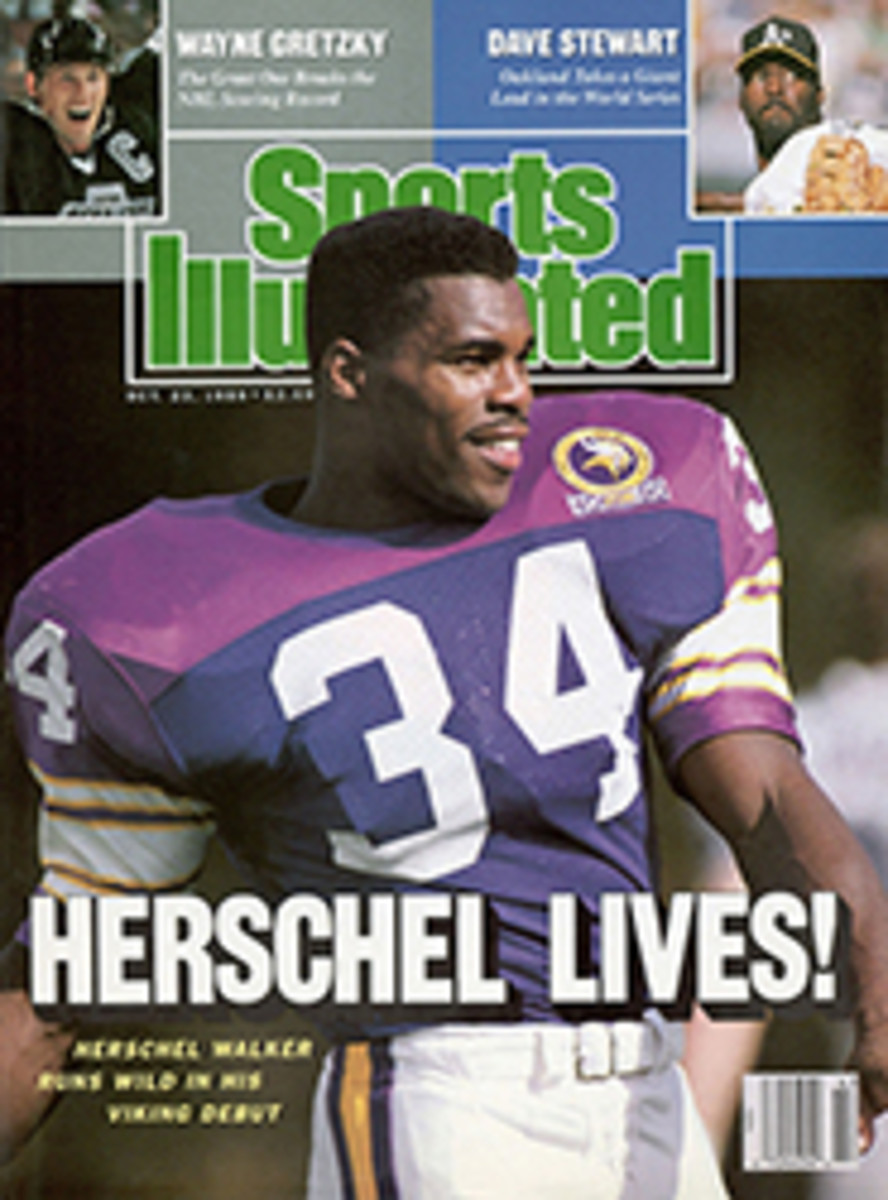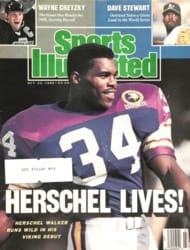
SCORECARD
ENDANGERED GATORS
The resignation under fire of football coach Galen Hall on Oct. 8 didn't end the troubles at the University of Florida. The NCAA said last week that it has been looking into the Gator athletic department since June and may not complete its probe until 1990.
Florida has been hit by a series of damaging revelations. Last year former Gator athletes were linked to drug use by a federal grand jury investigating a cocaine ring; testimony in that case alleged that basketball coach Norm Sloan paid players, a charge Sloan has denied. In May four sports agents were indicted for allegedly paying former Gator football and basketball players. The agents pleaded guilty to reduced charges, but not before their lawyers portrayed Florida athletics as a morass of rules violations.
The NCAA may decide to shut down the Gator football and/or basketball programs for one or two years. Under NCAA rules, any school found to have committed major rules violations in its programs twice during a five-year period automatically qualifies for this so-called death penalty. Florida football was slapped with three years' probation in January 1985 for violations that included improper recruiting activities and payments to players. The NCAA has the power to apply the death penalty even if the five-year cutoff has passed.
Hall has admitted to at least two NCAA violations: directing a graduate assistant to drive defensive back Jarvis Williams to an unnamed city in January of '87 to face charges of nonpayment of child support, and paying two Gator assistant coaches $22,000 from his own pocket in 1986-88. An NCAA rule stipulates that only the school can pay an athletic-department employee. "In the easiest example to understand, it prevents one booster downtown from running a program," said NCAA assistant executive director David Berst. "But the same thing applies in the case of a head football coach making payments to his staff members.... [By doing so] he would determine policies and create loyalties rather than the institution."
Florida is conducting its own investigation to make sure its athletic department gets cleaned up. But from the NCAA's viewpoint, that show of concern may be too little, too late.
WIDE LOAD
At 6'10" and 420 pounds, 17-year-old lineman Chris Perry of Covington (La.) High makes Refrigerator Perry, who is no relation, look like an ice bucket. Chris wears a size 19 shoe, a size 8‚Öù helmet and double-extra-large pants. This season he has toiled mightily to improve his fitness, paring his mile-run time from 25 minutes to 9:30 and doubling his bench press to 300 pounds. "Nobody on our team has better work habits," says Fighting Lions coach Jack Salter. "If we run up the stadium steps 10 times, it might take him longer, but he won't miss a step."
Chris, a senior, plays part time in the offensive line and at nosetackle. He has shown more interest in football than did his older brother, 6'7", 350-pound Ronald, who played sparingly and then quit the Fighting Lions before graduating in 1988. But the most promising Perry won't be eligible to suit up for Covington until next year. Adam, a 6'2", 270-pound ninth-grader, has more conventional dimensions for the game—at least for now.
STRAIGHT THINKING
Let's raise a cup of ice-cold soda to the Chicago Bears and their concessionaire, ARA Services, for establishing a designated-driver program at Bears home games. Any fan with a driver's license can go to one of three booths at Soldier Field before the kickoff and sign a statement that he will not be consuming any alcohol during the game because he will be driving others home after it. In return for this pledge, he receives a ticket and a button good for two free soft drinks at any concession stand. The fan also gets his hand stamped. No one with a stamped hand is allowed to purchase beer in the stadium.
So far this year, about 1,200 fans per game have signed up as designated drivers, with a high of 2,000 at the Oct. 2 Monday-night game against the Philadelphia Eagles. Only a handful have been caught attempting to buy beer. The program costs the Bears, ARA and the Chicago Park District (which owns Soldier Field) a few thousand dollars a game in lost soft-drink revenues. If it prevents even one serious accident, that's a small price to pay.
MEASURED REPLY
Even before the Giants and Athletics took the field for Game 1 of the World Series last Saturday in Oakland (page 34), baseball had come to overshadow other cultural pursuits in the Bay Area. San Francisco Chronicle columnist Herb Caen noted that back on Oct. 4—while the Cubs and Giants were in Chicago, playing the first game of the National League playoffs—the San Francisco Symphony was in Sacramento performing Nielsen's Symphony No. 2. After the third movement, conductor Herbert Blomstedt turned to the audience and passed along a bit of news that had been flashed to him from the wings. "Even in the midst of this melancholic music, there are happy moments." said Blomstedt. "I must interrupt this concert to tell you that the Giants have won 11-3."
Thereupon associate principal horn player Bob Ward loudly stage-whispered, "The maestro must be slipping. He used to be able to conduct the Nielsen without a score."
THE OLYMPIC MAGAZINE RACK
Earlier this month CBS sold a chunk of its U.S. rights to the 1992 and '94 Winter Olympics to Turner Network Television for $50 million. The deal lets CBS lay off some of the $543 million it spent to acquire rights to the two Games and gives cable viewers access to an additional 50 hours of programming in '92 and again in '94.
Everyone seems to benefit from the deal: CBS recoups some of its investment, TNT enhances its prestige, and the public—at least that portion with access to cable—gets to see some otherwise overlooked events.
But where might cable's entry into the Olympics lead? Former CBS president and TBS executive vice-president Robert Wussler, now president and chief executive of COMSAT Video Enterprises, a Washington, D.C.-based pay-per-view system, foresees a day when viewers will be able to tailor their Olympic viewing by purchasing only the events they want to see. That would be possible if several pay-per-view cable outlets such as his own combined forces to buy Olympic rights, then divvied up the events.
"Think of it as a big magazine rack," says Wussler. "You'll purchase only the magazines that interest you." It's an intriguing arrangement—and, alas, one that would raise the cost of watching the Games on TV.
ANOTHER BRIGHT IDEA
As the world series opened in Oakland, former Athletics owner Charlie Finley was at his La Porte, Ind., farm, watching on TV. The man who brought to baseball nighttime Series games, the designated hitter, colorful uniforms and white shoes would have loved to be in the Bay Area for the Giants-A's matchup, but, as he put it, "Nobody invited me." Finley didn't mention that if he hadn't moved the A's from Kansas City to Oakland in 1968, this year's Series wouldn't be the Battle of the Bay.
Since selling the Athletics in 1980, Finley, 71, has been working at his insurance business—he has Oakland's World Series trophies from 1972, '73 and '74 in his office—and applying his creative mind to a different sport: football. Just as Finley once tried to get the major leagues to use high-visibility orange baseballs—he struck out—he's now offering high schools and colleges another bright idea: the fluorescent football. "It could be the football of the future," he says.
The "visually enhanced prolate spheroidal sports ball," as the ball is referred to in Finley's patent application, is a standard football with eight yellow glow-in-the-dark stripes painted lengthwise on it. "In high school stadiums in particular, the lighting is often very bad," says Finley. "This will make the ball easier to see for everyone—players, officials and especially fans."
The ball made its debut in an Aug. 25 game between two Indiana high schools, Shelbyville and Greenfield Central, and since then it has been tried in high school and college games in five other states. Reaction has been positive. Notre Dame's Lou Holtz, one of several coaches to whom Finley has sent balls, wrote back saying he hopes Finley can get it approved by the NCAA.
"I just want to contribute something to the sport that will make it more enjoyable to the fan," says Finley, who next month will try to persuade the joint ad hoc football rules committee of the National Federation of State High School Associations (NFSHSA) and the NCAA to approve his creation. Says NFSHSA assistant director Dick Schindler, neatly summing up Finley's entire career, "Sometimes what might appear kooky may be a good idea."
—RICHARD O'BRIEN
ILLUSTRATION
PATRICK MCDONNELL
PHOTO
DAVID WALBERG
The painted pigskin has Finley aglow.
THEY SAID IT
•Joe Ferguson, the Tampa Bay Bucs' 39-year-old backup quarterback, who was named as one of America's sexiest men by a female newspaper columnist: "My wife hasn't said too much about it—since she stopped rolling on the floor, laughing."

